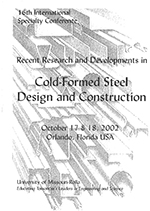Session Dates
17 Oct 2002
Abstract
This study is concentrated on the investigation of the shear lag effect on cold-formed steel tension members. C-shaped sections with different dimensions tested by using bolted connections were discussed in this study. The comparisons were made between the test results and predictions computed based on several specifications. In order to study the stress distribution at the various locations of the cross section of specimen, the finite-element software ANSYS was also utilized in this research. Based on the experimental results, it was found that the tension strengths of test specimens predicted by the AISC-Code (1999), which takes account of the shear lag effect, provide good agreement with the test values. The predictions according to AISI-Code (1996) and AS/NZS 4600 Code (1996) seem to be overestimated as comparing to the test results. It is also noted that there is quite a discrepancy between the test results and the values predicted by British Standard (1998).
Department(s)
Civil, Architectural and Environmental Engineering
Research Center/Lab(s)
Wei-Wen Yu Center for Cold-Formed Steel Structures
Meeting Name
16th International Specialty Conference on Cold-Formed Steel Structures
Publisher
University of Missouri--Rolla
Document Version
Final Version
Rights
© 2002 University of Missouri--Rolla, All rights reserved.
Document Type
Article - Conference proceedings
File Type
text
Language
English
Recommended Citation
Pan, Chi-Ling and Chiang, Pen-Chun, "Shear Lag Effect on Bolted C-shaped Cold-formed Steel Tension Members" (2002). CCFSS Proceedings of International Specialty Conference on Cold-Formed Steel Structures (1971 - 2018). 5.
https://scholarsmine.mst.edu/isccss/16iccfss/16iccfss-session10/5
Shear Lag Effect on Bolted C-shaped Cold-formed Steel Tension Members
This study is concentrated on the investigation of the shear lag effect on cold-formed steel tension members. C-shaped sections with different dimensions tested by using bolted connections were discussed in this study. The comparisons were made between the test results and predictions computed based on several specifications. In order to study the stress distribution at the various locations of the cross section of specimen, the finite-element software ANSYS was also utilized in this research. Based on the experimental results, it was found that the tension strengths of test specimens predicted by the AISC-Code (1999), which takes account of the shear lag effect, provide good agreement with the test values. The predictions according to AISI-Code (1996) and AS/NZS 4600 Code (1996) seem to be overestimated as comparing to the test results. It is also noted that there is quite a discrepancy between the test results and the values predicted by British Standard (1998).



